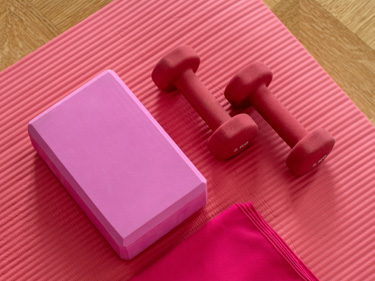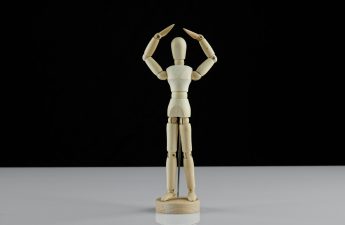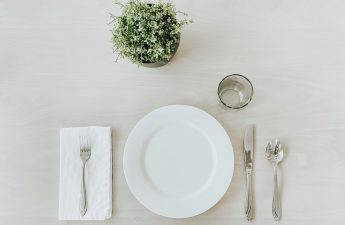
Being fit and fabulous at any age requires being attentive to changes in spatial awareness and basic body mechanics. The importance of foot placement, hip mobility and range of motion also become increasingly vital as you age. So training yourself to notice whether you frequently shuffle rather than step, in addition to how your body subtly shifts while transitioning from sitting to standing, may prevent falls and other injuries.
Being proactive in regard to maintaining your independence is another big motivation for engaging in regular exercise—either solo on in a group setting. The latter in particular comes with the added benefit of having a fitness professional on hand to provide suggestions for workouts that specifically focus on improving balance and proper form. Good posture is essential for the body’s longevity, plus can be difficult to correct without some guidance. And trainers or group exercise instructors can create programs to address the challenges a wide variety of individuals are facing by modifying activities to be doable for all participants.
It is also wise to remain clear on what your main goals are as the wellness journey progresses—as it is common for health priorities to shift as weight loss happens and/or a new decade of life begins. Key components of an “any age” fitness program should include:
- Balance
- Range of motion
- Core strength and awareness
- Neuromotor skills (which often directly correlate to daily living activities such as reaching, passing an object, etc.)
- Flexibility (incorporated via gentle stretching)
Which exercise habits have consistently worked for you? Tell the TOPS Community in the comments field below…then renew your commitment to pursuing well-being this Wednesday!



Thank you for the very encouraging article
And I VERY much appreciate the positive feedback, Barbara.
I have started working out in my pool and one thing I am doing to help my balance is walking backward across the pool. Has really helped me!
I do water aerobics almost daily love it
Water fitness classes really do provide a full body workout so glad to hear how much you enjoy them, Kamilcha.
Aquatic fitness was the first type of exercise I got certified to teach in. I think so many people underestimate how beneficial regular movement in water can be. So good for you, Donna!
An exercise habit that has worked for me most often is my own rule of 1. I can commit to one, one always feels easy when I think about it, and once I get going, I pretty much always do more than one (unless sick or injured, and even then I can usually find one of something I can still do). So: 1 strength move, 1 stretch, or 1 minute of cardio. Committing to 1 eliminates the overwhelming feeling, and allows me to begin. Once I begin, I can decide when to stop, even if that day, stop comes after 1. But it rarely does!
I LOVE this mindset, Lisa.
THANKS for sharing & keep it up!
Running and playing tennis are my favorite ways to exercise. I could definitely work more on flexibility, though.
I run three or four times a week as well, Robin. Then mainly stick to yoga the other days of the week as a proactive attempt to prevent injury from overly tight muscles (particularly in my legs). So yes, making time to stretch is important for multiple reasons.
I became interested in tai chi many years ago. The program I do is specifically designed to improve balance, range of motion and fall prevention. It is called Tai Chi for Arthritis and is recommended by the CDC. Besides being slow, continuous motion, it has been proven to be as effective as aerobics, but is MUCH easier on the body.
Thank you for taking the time to share this additional background info about Tai Chi, Karen. It sounds like an activity that is likely accessible to many other TOPS members as well so I hope some decide to give it a try based on what you’ve explained here.
We had a Tai Chi group come into our chapter to explain how it works
A few members went to check it out after & some continue to participate
I really like doing basic Qi Gong to help me be grounded each day. It helps me be more limber and feel good as I move my body in a healthy way. It helps me with my balance and posture awareness as well.
I have yet to try Qi Gong, Malena. But based on what you’ve shared here, I am certainly open to giving it a try.
I joined the YMCA take Chair Yoga- do variety of cardio and strength machines for an hour and Silver Sneakers program. Has made great progress in my health recovering after a large stroke. At first I had no energy but after I am so much better.
Very glad to hear this, Delores!
I taught several Silver Sneakers classes when I used to primarily work in the the fitness industry and agree it is a really accessible form of exercise for many people.
I’m 77 and at a healthy weight of 125, height 5’2″. I haven’t always been this low. In my 50’s I reached 170 pounds, which was the point of “obese”, Body Mass index 30. I was having sleep apnea and had to use a CPAP which never fit right, and other health issues.
Two things that made me decide to change were realizing I didn’t have a lap to hold my new grandchildren (and seeing a picture of me with one on my knee) and reaching the point that I couldn’t get down on my hands and knees to work in my garden. And realizing I couldn’t run, scratch my back, or many other normal things. And having to go to buy clothes at CJ Banks (plus sizes) instead of Christopher and Banks (max size 14 or 16).
I lost 15 pound on my own on a low-carb (not Keto or Paleo!) eating plan and then joined TOPS when I stalled. It has been terrific belonging to my group and especially nice when I reached my goal and became a KOP!
For exercise I garden a lot in the spring through fall. It’s great exercise with walking, digging, lifting, pushing, pulling, carrying, getting down and getting up – it uses the whole body.
I go to an indoor pool on rainy days and in the winter. I walk in the waist-deep water for several passes, both forward and backward. As Donna Shoults said, walking backward is more challenging! I take Zumba Gold in the pool twice a week in the winter. I also do Zumba Gold on land with a professional instructor. Zumba Gold can be modified for anyone to do.
I also walk up and down the stairs in my house, it’s just one flight. I aim to do it 10 times a day. I keep pennies on the bannister to count my rounds. I don’t always do all at the same time.
The Rule of 1 that Lisa shared is a great idea that I first read in the book “Mini Habits for Weight Loss”. His idea is to choose one exercise that you can do 1 of and do it everyday. It will often get you moving and you’ll do more. But, since you’ve only pledged to do 1, if that’s all you do, it’s a success for the day! You can add other “1’s” as you feel ready, such as eating 1 fruit or 1 vegetable more than you do now. One of mine is to do one plank.
The most important thing I have to do to keep my weight under control is to minimize, or better yet, eliminate sugar. Some days I do not have any. It’s true that sugar creates an appetite – for more sugar. The less I eat, the less I miss it. As Stephen Gullo wrote in his excellent book “Thin Tastes Better”, “The most dangerous words are “I’ll only have a little” .. of that chocolate cake, of that donut, of that ice cream … I’ve found this to be worth keeping in mind! It helps me avoid temptation. I recommend this book to everyone, it’s not only informative and motivating, it has great humor!
Anyone who doubts that sugar is truly bad for our health should read “Suicide By Sugar”. These are several other informative books about sugar. My local library has been my best friend as a source of diet, nutrition, health, and exercise books. It’s all free!
THANK YOU for sharing these book recommendations…& in addition to so many details about your personal wellness journey, Pat!
Wow Pat, what a great post. I am a member of TOPS NH0001 Hooksett NH and just beginning my weight loss journey. All of your tips, especially the local library is one I will use. Thank you for sharing.
You’re welcome, Margaret…And hope you’re making good progress on your goals thus far this year!
enjoy read these replies but does anyone have any idea about doing exercise when you have rheumatoid arthritis? Can’t do much walking or holding on to things because my hands are to sore.My bones are bad also.
Hi Annette, Good question!
Take a look at the Tai Chi for Arthritis and Falls Prevention and Walk With Ease website which I link to in this Wellness Wednesday blog: https://blogs.tops.org/wellness-wednesday/sweat-to-destress-this-holiday-season/